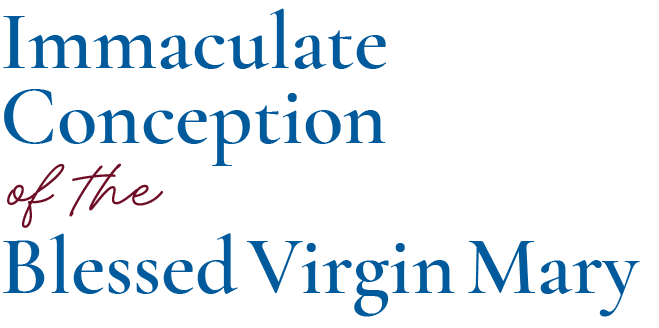About Us
Church of the Immaculate Conception of the BVM Sesquicentennial Celebration
“Be you also as living stones built up, a spiritual house…”
Long before Michigan was a Territory or State, there were Indian settlements in Lapeer County. It can be assumed that the tireless French missionaries, who ministered to the Native Americans wherever they could be found, passed through this area, and if so, these visits would mark the first masses celebrated in Lapeer. Supposedly, the French called the area “la pierre”—“the stone”—in reference to the rocky bed of the river that flows through the County.
By 1830, Michigan was a Territory, and in that year, Lapeer was designated the government center. As people began to settle in Lapeer County, Catholics were few and scattered; the celebration of mass occurred randomly and infrequently—only when a missionary priest happened to be passing through. It was not uncommon for these early Catholics to have no contact with a priest for many years at a time. As there was no church, mass—when it did take place—was celebrated in the homes of the faithful.
The first Catholics who arrived in Lapeer County settled in the southeastern region—near the “Scotch Settlement”, south of Imlay City. It was here, in the home of John Heenan, that the first mass in Lapeer County was celebrated. Nearer to the village, later city, of Lapeer, the first Catholic settler was Patrick Scully who built a home in 1834 in Mayfield Township. The next Catholic to come was William Halpin in 1838; he had a wife and two children. Soon other Catholics came—all of them, Irish.
When Michigan became a state in 1837, Lapeer was an established village. To encourage growth and settlement of the new state, it was decided to move all the official state institutions out of Detroit. Thus, Ann Arbor applied to be the seat of the new capitol; Lapeer applied to be the site of the new state university etc… People in those cities, however, were to be disappointed with the decisions of the distribution. Lansing was awarded the capitol; Ann Arbor was given the state university. As a consolation, Lapeer was promised that a major state hospital would be built in the future; Jackson was given the state prison etc…..
In that decade before the Civil War, priests from the small settlement of Flint visited Lapeer on occasion. But these infrequent visits did not foster a strong Catholic presence in the community. On August 17, 1859, Father DeCunic from Flint persuaded the founder of Lapeer, Alvin Hart, to procure property for the purpose of erecting a church. Generously, Hart provided the Catholics with a small parcel of property on the northern boundary of the village of Lapeer on the top of a hill where, today, Calhoun and Oregon Streets meet. As Catholics were viewed with suspicion and not particularly welcome in Lapeer, this location was chosen purposely to keep Catholics in the back of the town and “out of sight”. It not been forgotten that, in 1844, a visiting missionary priest, Father Laurence Kilroy, was pelted with stones by local youth! When Father Kilroy left Lapeer, he was convinced that Lapeer County was not a place for Catholics to settle.
During Fr. Kilroy’s visits to the area, he sought out any Catholics in the area. In his travels, he met some people, not of the faith, who were moved by his “untiring zeal and Christian charity” and were converted to Catholicism.
By October 1860, thanks to the efforts of Jerry Sullivan, the walls and the roof of a simple wooden church were erected, but the church was far from finished. At that time, the Bishop of Detroit made a promise that a priest would be assigned to Lapeer. But, there would be a long wait before this took place due to the tumult of the War Between the States. Finally, in October of 1864, as the Civil War was near its end, a 25 year old missionary priest from Germany, Father John Busche, arrived in Lapeer and was appointed pastor. At last, the Catholics of Lapeer were recognized as a parish. Upon his arrival, Fr. Busche undertook the completion of the Greek revival, wooden church which he named “Church of the Immaculate Conception of the Blessed Virgin Mary”—one of the first churches in America to bear that title. (Prior to his coming, it was thought that the parish would be under the patronage of St. Martin.) At his first mass in the uncompleted church, boards had to be placed on boxes as there were no seats. Besides finishing the construction of the church building in Lapeer, Fr. Busche organized the Catholics in Imlay City and in Davison where he built churches and eventually purchased land for cemeteries.
As there was no rectory, Fr. Busche lived in the homes of various parishioners until a parish house was purchased.
One of Fr. Busche’s first sermons in Lapeer was based on the Scripture passage from 1 Peter 2:5—“ Be you also as living stones built up, a spiritual house , a holy priesthood, to offer up spiritual sacrifices, acceptable to God by Jesus Christ. ” This would be a recurring theme during Fr. Busche’s long pastorate. The preaching of Fr. Busche, who spoke with a decidedly British accent, made an immediate impact on the people of Lapeer. Within months of his arrival, he made quite a few converts to the faith. By the 1880, according Fr. Alonzo Nacy, who grew up in Lapeer, half of the parish was comprised of converts.
For the next half century, the pastor of the church in Lapeer would be responsible also for the mission churches in Imlay City and Davison. Most of the parishioners in Lapeer and Imlay City were Irish, but, truly, they loved their “German” priest.
...and, this is how we began.


